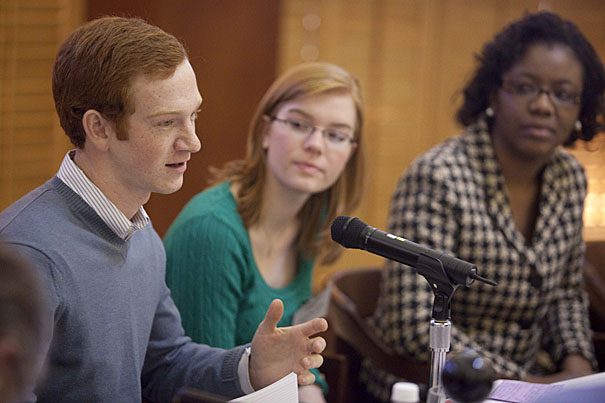
Kris Snibbe/Harvard Staff Photographer
Learning beyond the gates
Rappaport Institute meeting touts ‘engaged scholarship’
Marcel Moran ’11, a biology concentrator, plans on a career in medicine. But last semester he stepped aside from problem sets and laboratory experiments to venture into a course called “Reinventing Boston: The Changing American City.”
In a small way, Moran ended up reinventing himself, or at least changing the way he perceived the city across the river. His final project was a case study of the recently built Dudley Village Homes development in Dorchester, and how design — lighting, window placement, even playground layouts — can encourage community, reduce crime, and create a welcoming sense of safety.
Moran, whose Boston ties had been limited despite growing up in Cambridge, told the story of his foray into design, sociology, and urban history at the winter advisory board meeting last Friday (Jan. 29) of the Rappaport Institute for Greater Boston. The institute aided the course by arranging for local experts, many of them Harvard graduates, to be guest speakers.
“This lets you see Boston happening in real time,” he said of the course, a Gen Ed offering that satisfies the “United States in the World” requirement. “There are no hypotheticals.”
Moran was joined by two other students with similar stories.
Stephanie Miller ’10, a sociology concentrator, wrote a paper based on interviews with the directors of three Boston theater companies. “This class gave you that opportunity to have that collective experience” of living in a city, she said. “It’s a wonderful way to learn.”
And Hermioni Lokko, a third-year student at Harvard Medical School pursuing a joint master’s in public policy at the Harvard Kennedy School (HKS), teamed up with two others on an institute-aided project to assess emergency preparedness at the Codman Square Health Center in Dorchester, a place Lokko said she had never been before.
She co-wrote her fall paper for MLD-601, an HKS operations management course co-taught by Guy Stuart and Mark Fagan. (Stuart is an HKS lecturer in public policy. Fagan is a senior fellow at HKS’s Mossavar-Rahmani Center for Business and Government.) The course requires practical engagement outside the classroom.
“It was,” said Lokko, a native of Ghana, “a wonderful way to get out of the Harvard bubble.”
The Dorchester project was an introduction to the world of community health centers, she said, giving students a chance to apply classroom lessons in the real world and to learn what it takes to execute a project. Among the many unexpected lessons, said Lokko, is that data doesn’t always come in handy spreadsheets. She and fellow students, in assessing the center’s capacity, for instance, spent time counting chairs, observing client flow, and evaluating floor plans.
Courses that blend traditional learning with hands-on experiences in Boston encourage “engaged scholarship,” said institute executive director David Luberoff, who co-taught the recurrent undergraduate course with Christopher Winship, Harvard’s Diker-Tishman Professor of Sociology.
“The goal is to take advantage of geography,” he said, “and give students the chance to better understand what they are learning in the classroom by having them see it and do it in the community.”
The advisory board event also featured an overview of state and local fiscal issues by three officials, all of them former Rappaport Urban Scholars at HKS. They liked the idea of activity-based learning, a practical and positive facet of the town-gown relationship.
“We’re getting great horsepower on issues” from students, especially in “decision-making support,” said Barbara Burke, a senior adviser to Boston Mayor Thomas Menino. She works with the institute and faculty members to develop and carry out course-based projects.
Burke called the students “neutral, smart, fact-based individuals.”
A good addition to the concept would be a systematic view of Harvard courses that require on-the-ground projects in Boston, perhaps “mapped against” the policy needs of the city, she added. “You have a lot of assets.”
Continuity from course to course would help too — with successive semesters of students building on each other’s work, said Rappaport advisory board member Tiziana Dearing, M.P.P. ’00. She is president of Catholic Charities of the Archdiocese of Boston, a client for several institute-supported projects.
Like several other advisory board members, Dearing was a guest speaker in the Boston class, where the two weekly lectures usually featured local experts in areas including education, housing, the arts, public safety, business, social services, politics, governance, and public policy.
Moran said the speakers helped to create a sense of excitement and vitality in the classroom. “There’s definitely a buzz about this course,” he said. “There’s a feeling this was something special.”
“Engaged scholarship” widens a student’s sense of how and where learning occurs, and it also encourages pathways to public service, said Christine Heenan, Harvard’s vice president of Harvard Public Affairs and Communications, who attended the Rappaport meeting. Learning in the classroom alone, she said, “makes it easy to stay too close to campus.”
In addition to the students and elected officials, the two-hour meeting in HKS’s Taubman Building included two more special guests, by way of a large-screen video link in the back of a fifth-floor conference room: real estate developer and philanthropist Jerry Rappaport ’47, LL.B. ’49, M.P.A. ’63, and his wife Phyllis.
In 1997, they and other members of the family created the Phyllis and Jerome Lyle Rappaport Foundation. In 2006, the Rappaport family and foundation provided an endowment gift to fund the core operations of the Rappaport Institute. The Harvard-wide entity aims to strengthen ties among the region’s scholars, students, officials, and civic leaders.
From the den of his Florida home, Rappaport said he was happy to see that Harvard’s students and scholars were helping local leaders address key issues. In so doing, he said, “the academic world has really benefited.”




